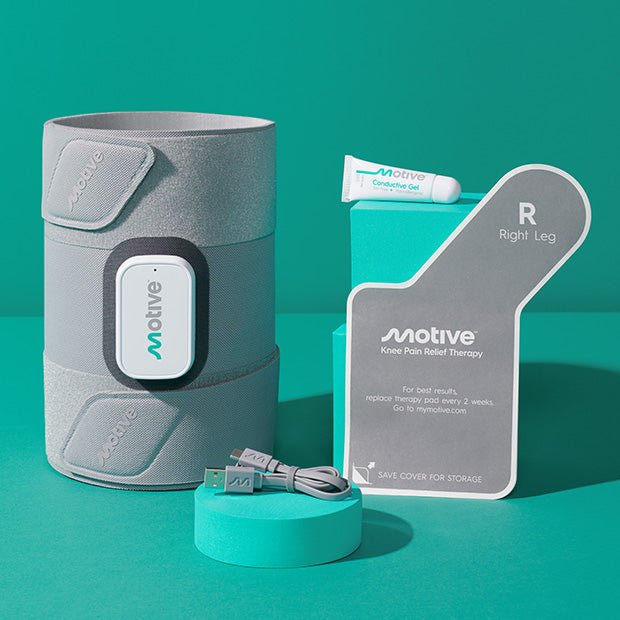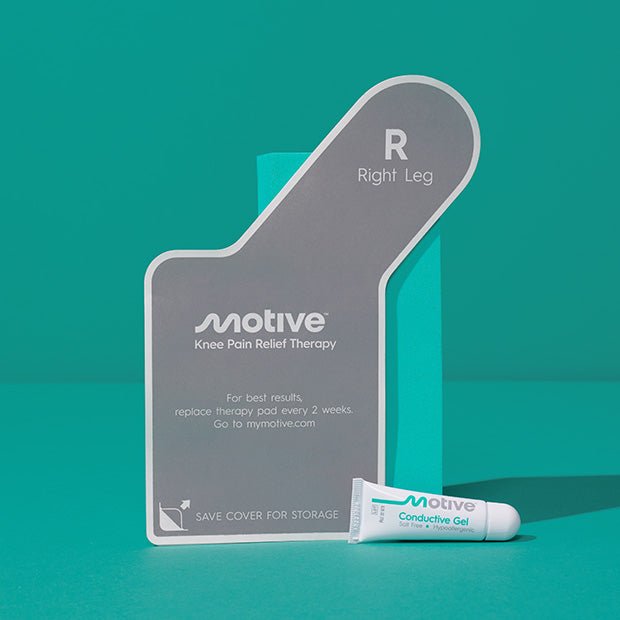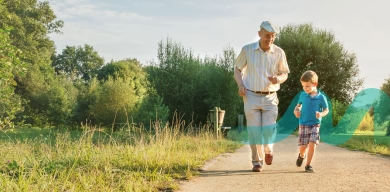
Did you know knee pain is one of the most frequently reported joint pains in the United States?
It’s one of the most common problems among the elderly and increases in frequency and severity with age. Knee pain not only hampers physical function but also diminishes quality of life, leading to a greater need for assistance in daily activities.
One of the most common causes of knee pain is osteoarthritis. It can affect any joint and cause inflammation and discomfort, making it difficult to do everyday tasks. Knee osteoarthritis is recognized as the fourth most prevalent cause of disability globally.
Other causes of severe knee pain include rheumatoid arthritis, knee injury, sprains, and overuse of joints that lead to muscle weakness, swelling, and irritation in and around knee joints.
If you or someone you love is suffering from knee pain, Motive Knee Therapy, the only FDA-cleared muscle stimulation therapy, can help you regain your life. The device improves mobility and eases knee pain due to arthritis or any other causes by strengthening the muscles around the joint.
In this article, we will further explain knee pain, provide tips on knee pain management, and explain how Motive therapy can be a proven solution for your arthritis pain and other knee problems.
Understanding Knee Pain
Managing knee pain depends a lot on understanding the underlying cause. Knee pain is not restricted to age; it can affect people of any age group. It can be caused by medical conditions, such as gout, arthritis, and infection, or knee injuries that can lead to torn cartilage and ruptured ligaments.
Osteoarthritis is one of the most common causes of knee pain in the elderly, especially people over 50. Additionally, women and individuals who are overweight have a higher likelihood of experiencing knee pain regardless of their age. Athletes who experience repetitive stress injuries (such as anterior cruciate ligament (ACL) injury and torn meniscus) also increase their risk of developing knee pain.
Different knee pain conditions require different treatment approaches, which is why understanding the root cause becomes essential during knee treatment. Normally, the cause of knee problems is diagnosed using physical examination combined with imaging techniques such as MRI, CT Scan, or X-ray.
Tips for Managing Knee Pain
Many knee pain treatment options are available today to improve mobility in individuals. This includes:
- Medication (Examples include painkillers or pain relievers, over-the-counter non-steroidal anti-inflammatory drugs (NSAIDs), such as ibuprofen and naproxen, antidepressants, such as duloxetine and acetaminophen, or glucosamine and chondroitin supplements)
- Strengthening muscles
- Topical creams or sprays
- Physical therapy
- Surgeries (like total knee replacement surgery and arthroscopy)
- Acupuncture
- Steroid injections
Always consult with your healthcare specialist or orthopedic doctor about which therapy is right for you.
In most cases, knee problems, such as injuries or osteoarthritis, impair the quadriceps, hip muscles, and hamstrings. Therefore, strengthening muscles around the knee joint can significantly improve the condition and alleviate knee pain.
Here are five tips to manage knee pain without using medications or surgeries:
Proper Posture and Body Mechanics
Correct body postures and body movement are simple yet effective ways to alleviate knee pain. Proper alignment reduces strain on the knee joints, promotes balanced muscle development, and enhances overall stability.
The following recommendations can help minimize knee strain:
- Maintain good posture, avoid slouching or leaning while sitting.
- Avoid low chairs and sofas that cause sinking
- Avoid prolonged sitting and extended periods of immobility to prevent joint stiffness and pain
- Use a pillow while you sit, if needed
- Wear shoes with good arch support to prevent abnormal knee pressure.
By making slight adjustments to your daily routine and activities, you can experience great improvement in your knee pain.
Weight Management
Keeping a healthy weight can make a significant impact on your knee health. Excess weight or obesity increases the risk of knee pain or severe knee conditions due to stress on the knee joints. Additionally, it increases knee inflammation. So, weight loss, even just a few pounds, can also be helpful to improve your knee pain.
Eating a healthy and balanced diet, including fruits, vegetables, low-fat meat, high-fiber food, and limited sugar and salt can help you manage a healthy weight and keep stress off your knees.
The Arthritis Foundation recommends fresh fruits and vegetables as an ideal diet for those with arthritis.
Low-impact Exercises and Stretches
Though exercising while experiencing knee pain may sound scary, it can help significantly improve your knee pain if done right. Exercise that strengthens the quadriceps muscles, located at the sides and front of the thighs, can safeguard the knee joint. You should work with a physical therapist or doctor to learn about the specific exercises or programs that you can do to fit your medical needs.
For improved knee health, you can incorporate the following exercises into your daily routine:
- Inner thigh stretches
- Squats
- Standing knee lifts
- Straight leg raises/lifts
- Standing hamstring curls
The strengthening exercises tailored for minor knee injuries and mild pain not only alleviate discomfort but also promote stability in the knee.
Pain Management Techniques
Managing knee pain is essential to managing the quality of your life. Other than maintaining a healthy weight, following a balanced diet, and doing light exercises, you can also follow these techniques to manage your knee health:
- Use Ice packs: Apply ice packs covered in a towel on the affected knee area if you are experiencing swelling. Keep icing until the swelling goes down. It helps alleviate both pain and inflammation in the knee. However, do not keep the packs on for more than 20 minutes; otherwise, you may damage your skin and nerves.
- Heat: Apply a hot water bottle or heat pack as an effective way to temporarily relieve knee pain. If you are suffering from joint tightness or stiffness, you can get relief right away. Avoid using heat if you have swelling.
Using Motive Therapy
Motive is an FDA-cleared knee pain treatment device. Like other knee pain management approaches, it does not offer temporary relief from knee pain but rather long-lasting relief. It enhances your knee health by strengthening thigh muscles with just 30 minutes of use per day. The device is easy to use and can be performed in the comfort of your home.
Motive is also a doctor-recommended therapy to alleviate knee pain. Clinical studies have shown improved knee mobility and strength in patients after one month of use.
Motive is an effective, easy-to-use, and prescription-free therapy to address knee pain and enhance your quality of life.
Lasting Knee Pain Relief Begins with Motive
Knee pain is one of the most prevalent joint problems in people of all ages, and can arise from knee injuries or arthritis. Types of arthritis that primarily affect knee joints include knee osteoarthritis, rheumatoid arthritis, and posttraumatic arthritis.
These conditions can be treated using medications, surgeries or by implementing small changes to your daily activities, such as correcting posture, weight loss, healthy eating, and low-impact exercise.
However, these treatments may offer only temporary relief.
In such cases, Motive therapy, an FDA-cleared and orthopedic-recommended knee pain treatment device, stands as a proven solution to create lasting knee pain relief in the comfort of your home. The device is controlled through an app on your phone and is easy to operate and track your treatment progress over time.
It gives you the flexibility to set a suitable stimulation intensity based on your knee condition.
Unlike other knee treatment approaches, Motive does not mask knee pain but treats one of the primary root causes: muscle weakness. It contracts and moves your muscles around the knee to strengthen them and take stress off your knee joints.
Using proprietary NMES (Neuromuscular Electrical Stimulation) the device strengthens your quadriceps muscles, increases mobility, and provides long-lasting relief from your knee pain.
So, if you are ready to get back to your life and enhance your quality of life, choose Motive Therapy TODAY!
Have questions regarding the device or therapy? Reach out to us—we’re here to help!




